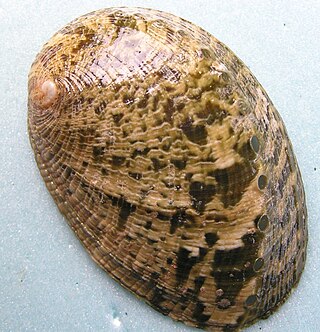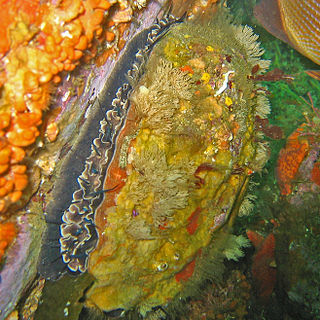
Abalone is a common name for any small to very large marine gastropod mollusc in the family Haliotidae, which once contained six genera but now contains only one genus, Haliotis. Other common names are ear shells, sea ears, and, now rarely, muttonfish or muttonshells in parts of Australia, ormer in the United Kingdom, perlemoen in South Africa, and pāua in New Zealand. The number of abalone species recognized worldwide ranges between 30 and 130 with over 230 species-level taxa described. The most comprehensive treatment of the family considers 56 species valid, with 18 additional subspecies.

Haliotis cracherodii, the black abalone, is a species of large edible sea snail, a marine gastropod mollusk in the family Haliotidae, the abalone.

Haliotis australis, common name the queen pāua,yellowfoot pāua, or austral abalone, is a species of edible sea snail, a marine gastropod mollusk in the family Haliotidae, the abalone.

Haliotis virginea, Virgin pāua, is a species of edible sea snail, a marine gastropod mollusk in the family Haliotidae, the abalone.

Haliotis laevigata, common name the smooth Australian abalone or greenlip abalone or whitened ear shell, is a species of sea snail, a marine gastropod mollusk in the family Haliotidae, the abalone.

Haliotis rufescens is a species of very large edible sea snail in the family Haliotidae, the abalone, ormers (British) or pāua. It is distributed from British Columbia, Canada, to Baja California, Mexico. It is most common in the southern half of its range.

The pink abalone, scientific name Haliotis corrugata, is a species of large edible sea snail, a marine gastropod mollusk in the family Haliotidae, the abalone.

The blacklip abalone, Haliotis rubra, is an Australian species of large, edible sea snail, a marine gastropod mollusk in the family Haliotidae, the abalone.

Haliotis discus, commonly called disk abalone or Edo abalone, is a species of abalone sea snail.

Haliotis fulgens, commonly called the green abalone, is a species of large sea snail, a marine gastropod mollusc in the family Haliotidae, the abalones. The shell of this species is usually brown, and is marked with many low, flat-topped ribs which run parallel to the five to seven open respiratory pores that are elevated above the shell's surface. The inside of the shell is an iridescent blue and green.

Haliotis glabra, commonly called glistening abalone, is a species of sea snail, a marine gastropod mollusk in the family Haliotidae, the abalones.

Haliotis jacnensis, common name Jacna abalone, is a species of sea snail, a marine gastropod mollusk in the family Haliotidae, the abalones.

Haliotis mariae is a species of sea snail, a marine gastropod mollusk in the family Haliotidae, the abalones.

Haliotis rugosa pustulata is a subspecies of sea snail, a marine gastropod mollusk in the family Haliotidae, the abalones.

Haliotis scalaris, common name the staircase abalone or the ridged ear abalone, is a species of sea snail, a marine gastropod mollusk in the family Haliotidae, the abalone.

Haliotis semiplicata, common name the semiplicate abalone, is a species of sea snail, a marine gastropod mollusk in the family Haliotidae, the abalone.

Haliotis walallensis, common name the flat abalone, is a species of sea snail, a marine gastropod mollusk in the family Haliotidae, abalone.
Haliotis melculus, the honey abalone, is a species of sea snail, a marine gastropod mollusk in the family Haliotidae, the abalone.

Haliotis parva, common name the canaliculate abalone, is a species of sea snail, a marine gastropod mollusk in the family Haliotidae, the abalones.

Haliotis, common name abalone, is the only genus in the family Haliotidae.




















